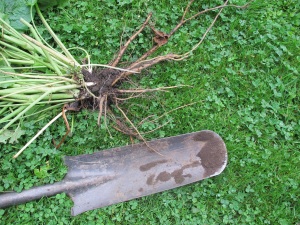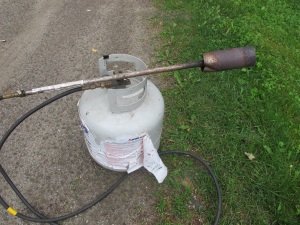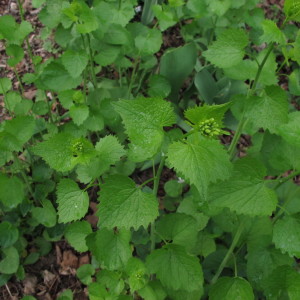Weeding
I love weeding. It creates order out of chaos, something I have come to appreciate. An un-weeded flower bed is full of distractions. My brain is constantly instant messaging me: “See that dandelion? You should pull it”. The weeds distract me from the beauty of the flowers and the texture and color of the leaves. I feel better as soon as I get my weeds pulled. That said, I still have weeds. Maybe I need to retire from writing a column!
Weeding also makes my plants thrive. Weeds compete with vegetables and flowers for sunshine, moisture, nitrogen and micro-nutrients. In the early spring when my perennials are just waking up, I am very careful not to yank their little green sprouts, thinking they are weeds. In fact, I often let some of my weeding go until late May or even mid-June when everything is obvious.
Dandelions, weeds that I don’t mind in the lawn, can get a bit rambunctious in the garden beds, and I pull them without compunction. Because they have a deep taproot, they are best pulled when the soil is moist. I use a long narrow shovel, one sold as a “drain spade” to loosen the soil down 12 to 16 inches. This spade is just 6 inches wide but the blade is16 inches long. I push the blade deep into the soil, pull back a little, then push it forward, and then slowly pull out the weed, the slower the better.
Sometimes I see a little dandelion and just grab it and pull – only to have the top break off while the roots remain. Whenever you leave dandelion roots, or even fragments of root, the plant will grow back.
Burdock and thistles also have tap roots, some going down very deep. The older the weed, the deeper the root. I’ve pulled mature burdock plants with roots nearly two feet deep. This is only possible when the soil is moist.
It’s really critical, especially for any weed that produces lots of seeds, that you not let them flower. If you don’t have time to dig them out, at least snip off the flowers. Many weeds have green flowers, and some will produce seeds even after being pulled if they have already formed flowers. I don’t throw noxious weeds, things like goutweed, in the compost pile for fear they will grow and spread – or leave seeds.
My favorite weeding tool is the CobraHead weeder (www.CobraHead.com). This is shaped like a tine on farmer’s cultivator – or a bent steel finger. I like it because it is narrow in profile and curved in a way that allows me to easily get the blade under the roots of a weed. I pull from below with the CobraHead while pulling the tops from above. I drag it through the soil in a bed after weeding and am always surprised by now many fragments of root it brings to the surface. I can use it with one hand or two. I use it for loosening the soil while planting, too. It is neither right- or left-handed, it is lightweight, and the handle is made from re-cycled plastic.
The CobraHead is great for teasing out long roots, too. I once pulled out a root 39 inches long in one piece, just gently loosening with the tool while tugging on the weed. That root was from a Queen of the Prairie (Filipendula rubra), a lovely pink-flowered perennial thug. It’s great for teasing out roots of invasive grasses.
Another great weeding tool is a favorite of my comic hero, Calvin, of Calvin and Hobbes. I refer to my flame thrower. It is technically a flame weeder, but Calvin and I refer to it as a flame thrower. It’s a metal wand on a 10-foot rubber hose attached to a propane tank normally used for gas grills. Light it, and it sends a flame out of the nozzle that will turn any weed crispy in an instant.
I often use my flame weeder on freshly turned soil. I let weed seeds germinate for a week or more, then burn them off before I plant. I try not to disturb the flamed soil when planting, as seeds that have been buried deeply will not germinate, but those on the surface, or near the surface will. Many weeds have what I call a photo-trigger. No light? They won’t germinate. Or I will flame, then plant seeds, then flame again before my carrots are up. Available from Johnny’s Selected Seeds or Fedco Seeds.
One of the worst weeds in the world is garlic mustard. Not only will it outcompete other plants in the understory, it can grow in full sun to full shade, and can produce many tens of thousands of seeds per square yard. Garlic mustard is also allelopathic, meaning that it produces chemicals that inhibit the growth of other plants and mycorrhizal fungi needed for healthy tree growth and tree seedling survival.
A friend last year hired a guy to pull all the garlic mustard under her trees and shrubs. It pulls easily, and he quickly filled wheelbarrows full of mature plants. But this year there were thousands of tiny garlic mustard seedlings popping up all over, even in the bark mulch he had put down. I lent him my flame weeder, and in no time he had burned off the small plants.
Many weeds can be deterred by a good thick layer of mulch. Seeds don’t germinate, or seedlings can’t push through the mulch, particularly if you lay down 4-6 sheets newspaper before mulching. Other, aggressive weeds will. Mature Japanese knotweed roots have been said to push through an asphalt driveway! Still, most garden weeds are really just enthusiastic plants that want to be your friends! My practice is to pull weeds every day, and that way I hope to finally beat them. Hah!
Henry is a garden writer, public speaker and garden consultant. He lives in Cornish Flat, NH. You may reach him at henry.homeyer@comcast.net.





